Types of echeveria: classification and popular varieties

Echeveria - refers to the perennial herbaceous succulent plants of the bastard family. In its natural environment, it can be found in Mexico, some species grow in the United States. Due to its extraordinary appearance, the flower is increasingly used both for decorating alpine slides and various flower beds, and as a houseplant.
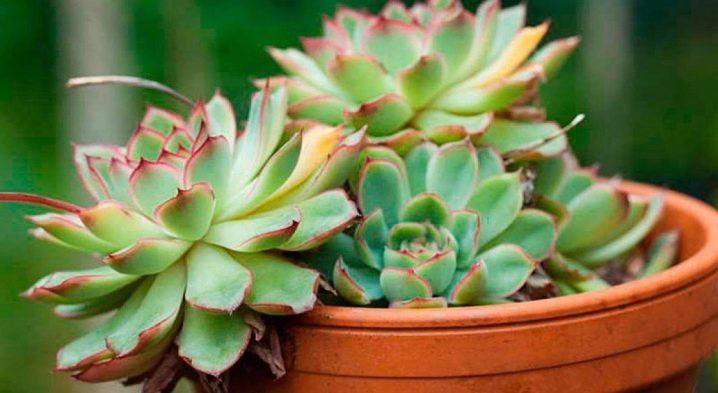
Description
Echeveria is a perennial plant with a low, massive stem. The dense, compact leaves gather in a squat rosette, similar to a rose flower. Because of this similarity, the plant received another name - stone rose. The leaf plates are predominantly oval, with an upper pointed part. During flowering, small, bell-like flowers appear on thin, branchy peduncles. Inflorescences are medium, with slightly drooping racemes. The stone rose blooms profusely, and with proper care, flowering can resume. This variety has many varieties, which can differ in color and shape of the leaf plates.
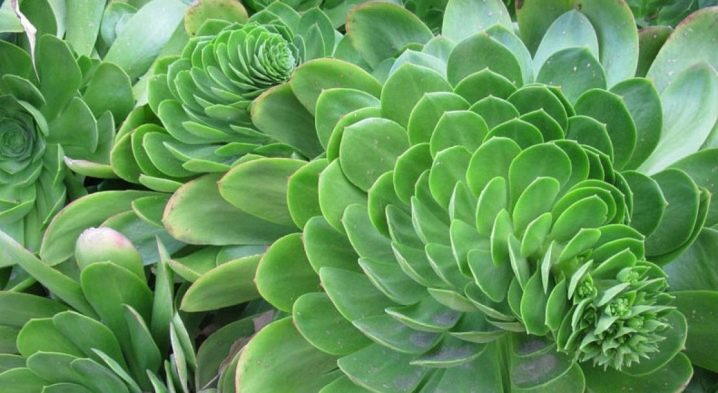
Classification
The systematization of the types of Echeveria is quite extensive. The varieties of this plant are divided according to the following criteria:
- by structure - there are varieties with dense or loose rosettes;
- by the color of the plates - the leaves of the hybrids are characterized by different colors, it can be all shades of green, pink, purple, red;
- on the root system - the roots of a plant are both superficial and filamentous;
- along the stem - there are varieties with a rosette growing from the soil, or creeping when it rises above the ground;
- according to the color of the leaves under special lighting - with red or yellow.

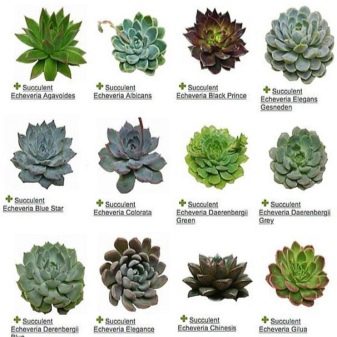
Popular varieties
The types of echeveria amaze with their extraordinary leaves, and each of them is charming and eye-catching in its own way.
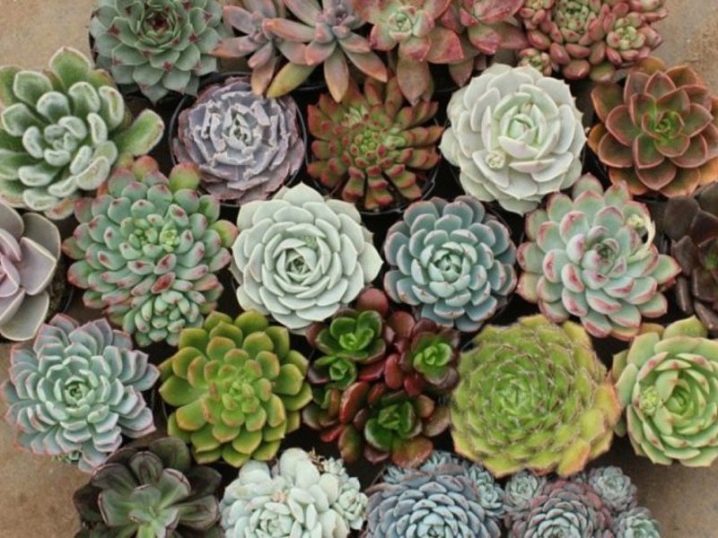
Agave
It has a constant bushy shape. The plant can reach a height of 25-35 cm. In appearance, the rosette looks like a water lily. It has a short stem. The leaf plates are smooth to the touch and are symmetrically positioned. They are painted in a gentle green tone with a slight red tint at the tips. Representatives of this variety bloom in late autumn or early winter. The flowers are small, about 1.5 cm in diameter, in different colors +, usually red or yellow.
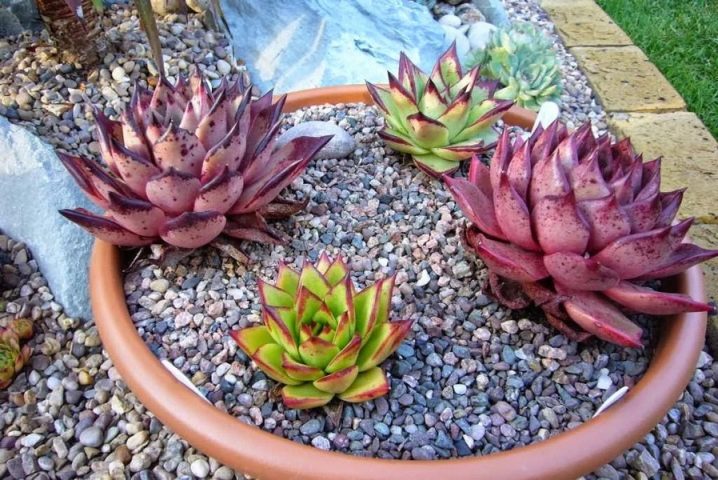
Affinis
The bush is rather undersized, the stem grows up to 5 cm. Small leaves are deep dark green, almost black, color. The upper part of the sheet plate is without deflection, almost flat. With a lack of the necessary lighting, the leaves lose their dark shade and become lighter in color, and their shape becomes elongated.
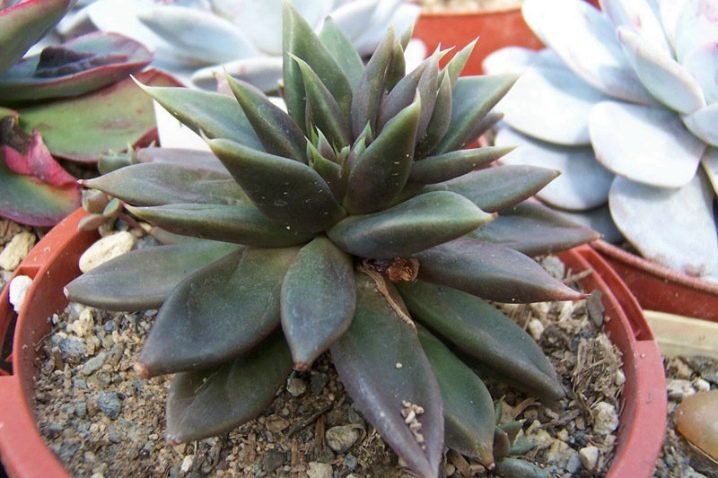
It is necessary to moisturize the plant in the early morning or late evening, when there is no sunlight. When watering in the daytime, drops of water caught on the leaf plates cause burns on the fragile leaves.
Graceful
This hybrid belongs to the stemless varieties, since it does not have a main stem. The leaf plates are rounded, with sharp peaks directed upwards. The rosette is similar to a lotus flower. The leaves are small, 5 cm long and 2 cm across, light green in color. The upper side is covered with a bluish pile. It cannot be washed or washed off - this is a specific feature of the plant. After damage, the villi do not renew, and the flower loses its decorative effect.The plant has a well-branched, long peduncle with bright orange or pink-red bell-like flowers. The edges of the petals are covered with a yellow frame.

Derenberg
The rosettes of this plant are flat and regular in shape. The leaves are very densely arranged in them. This variety belongs to the creeping variety. The leaf plates are somewhat rectangular, gray-green. The edges are outlined in pink. The plant begins to bloom in mid-spring. On low peduncles 3-4 flowers of deep bright yellow color appear.
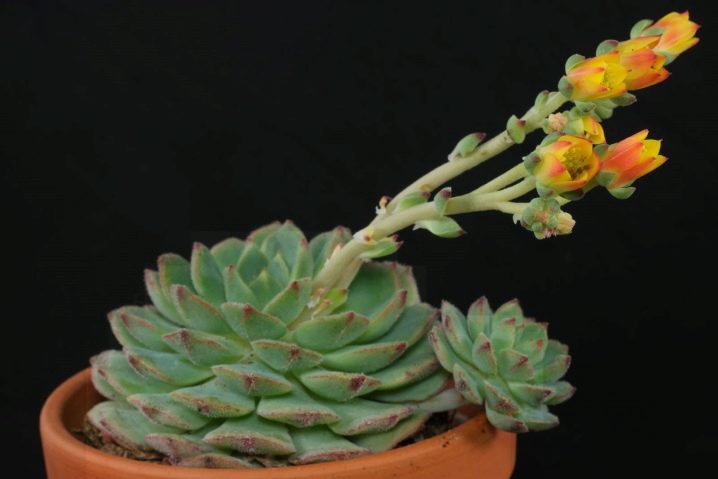
Humpback-flowered
It is characterized by a tree-like stem. At the tips of the branches, large rosettes are formed, consisting of 15-20 leaves of a greenish color with a bluish tint. The leaf plates, in comparison with other varieties, are rather large, have the shape of an irregular, somewhat curved oval with wavy edges. Their surface is covered with irregular growths. It is because of these formations that Echeveria acquired its name.
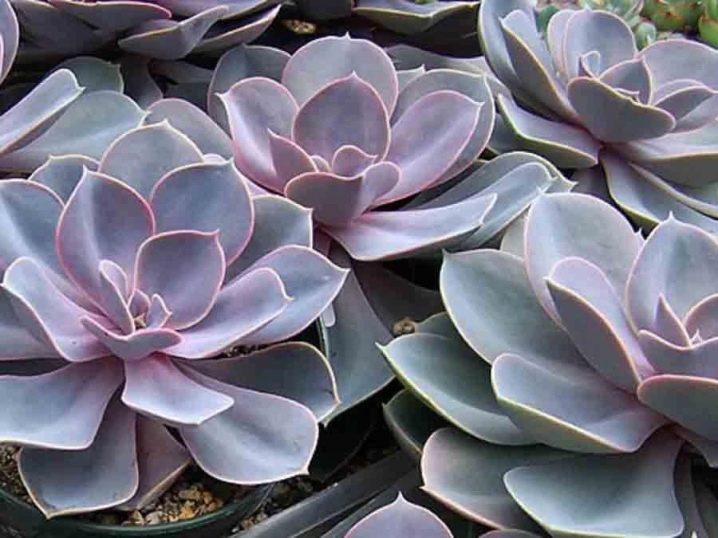
The buds appear at the end of August. The plant blooms for a long time, the flowers can last until mid-winter. On long peduncles, spherical buds of a scarlet hue are formed, and the blossoming flower has the shape of a small bell. The color of the petals is variegated: they are red on top, and the middle becomes yellow. One of the most famous representatives of this variety is the Magic Red hybrid.
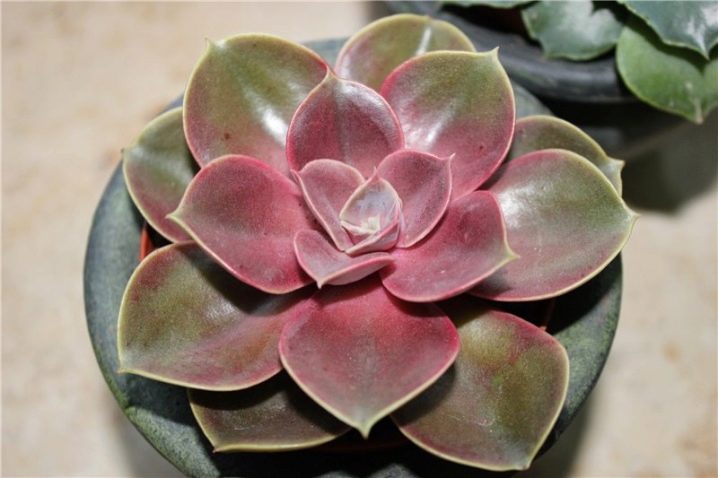
Metal-flowered
A distinctive feature of this variety is the presence of an intense metallic sheen on green leaf plates. Almost all specimens of the bastard family bloom at home, if the necessary microclimate is created, but the flowers of this variety do not form arrows with buds.
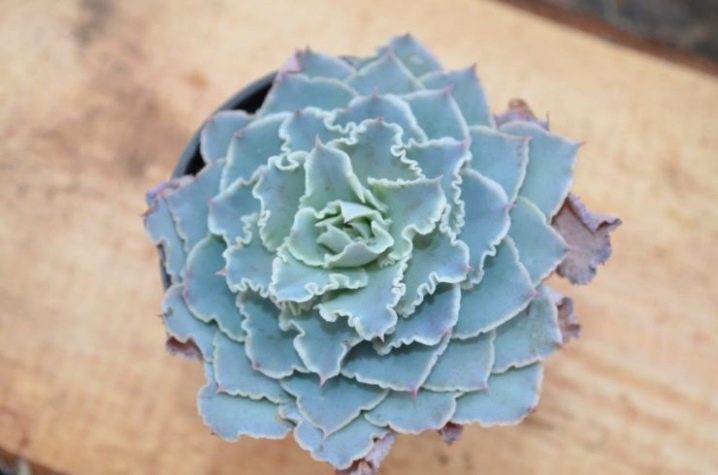
Lau
The plant got its name from the name of the botanist, who was the first to notice the new variety and describe its key qualities. The flower has a large trunk, reaching 2-3 cm. A feature of this species is considered to be thickened leaves, covered with a kind of waxy bloom. The same coating is found on the petals of flowers.
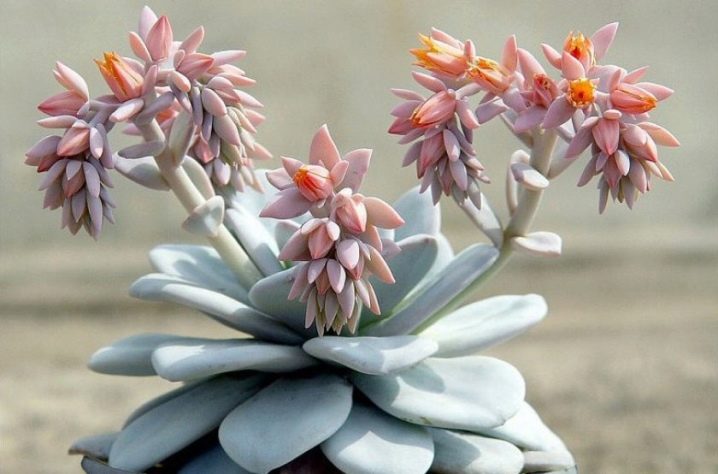
This shell is very delicate, but it is a kind of protective barrier for the plant. Therefore, the flower must be handled very carefully so as not to damage this layer.
Shiny
In appearance, the bush is rounded, but the leaf plates themselves are of a clear geometric shape. The plant does not have branches, the leaves are somewhat elongated, elastic. Some varieties have wavy or shallowly grooved leaf plates. The coloring is a bluish tone with a slight green tint. Flowering occurs at the end of winter, but can continue until mid-spring. Blooms densely, forming many peduncles. The flowers are small, similar to bright red bells, with a yellow border along the entire edge. Gardeners consider the Flying Cloud to be the most popular hybrid of this variety. In its appearance, the bush is very similar to an air cloud, and the tips of the leaf plates have a slight pink edging.
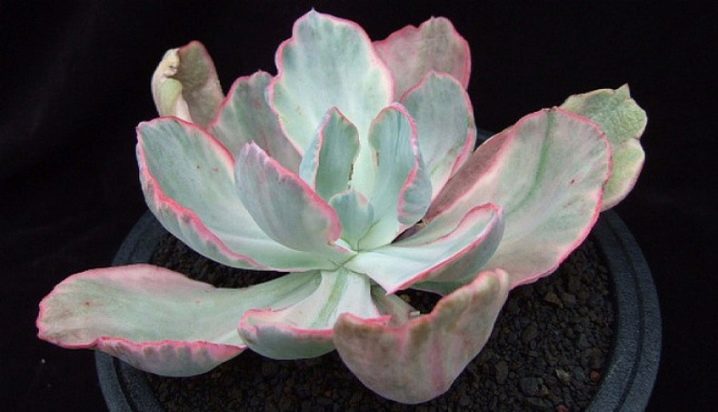
Bristly or setosis
It is distinguished by a very short stem or its absence. The leaves, completely covered with a thin whitish pile, form a spherical rosette. It is also overgrown with villi and a peduncle, which can grow up to 30 cm. The shrub blooms from May to July. The petals have a smooth transition from red to yellow.
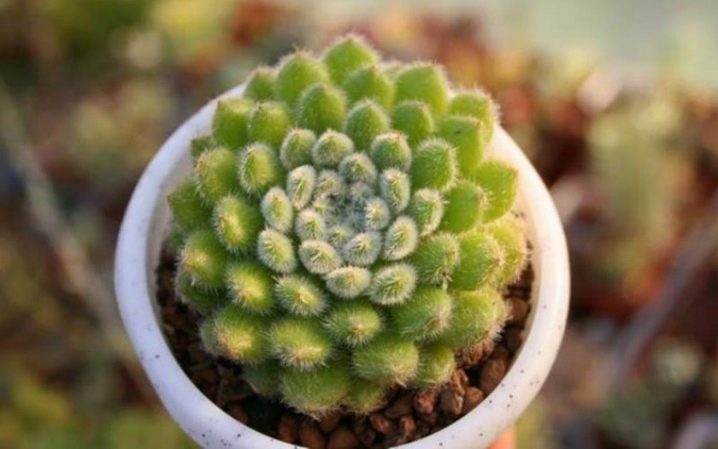
Shaviana
Leaves of a beautiful purple tone with a gray tint. The edges of the leaves are wavy, tinted in a pale pink color. The border is present in the presence of good, bright lighting, and if the plant is too shaded, the border fades, losing its showiness. The rosette is rather large, can reach 20 cm, and is placed on a thick stem. The flowering period lasts from July to August. The flowers have an intense pink color.
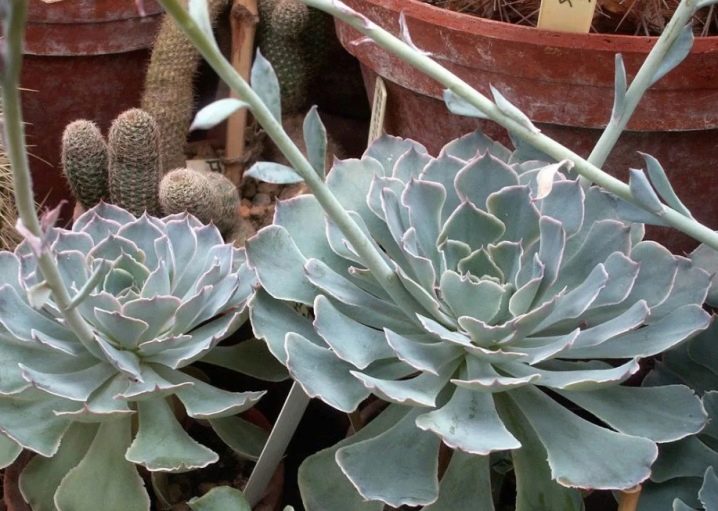
Pearl of Nuremberg
It has characteristic sharp tops on the leaf plates.Volumetric rosettes growing on a powerful straight trunk consist of brownish-gray leaves with a pink sheen. Flowers appear at the end of spring and are characterized by a pastel, scarlet hue.
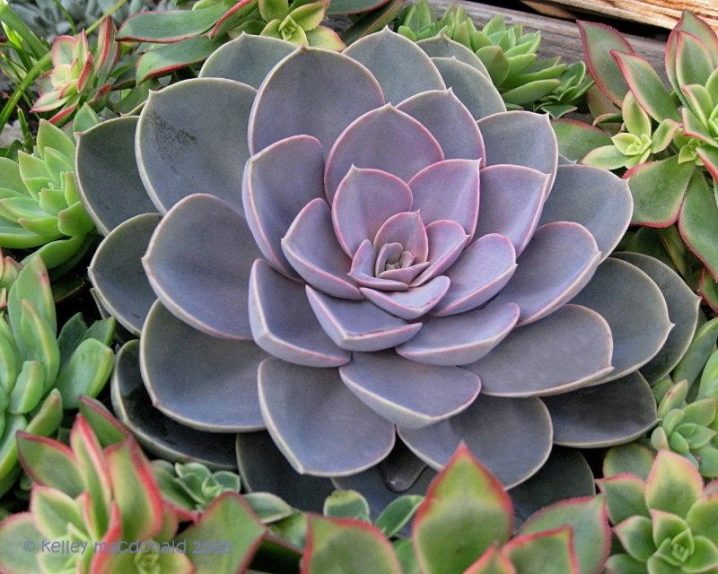
Crimson or "Purpuzorum"
Representatives of the variety are not large in size. Their main distinguishing feature is the original structure of the leaf plates - they are triangular with pointed peaks, rather rigid in texture. Leaves of olive or marsh color with many brown blotches. At the end of spring, it blooms with red bells with yellowish highlights.
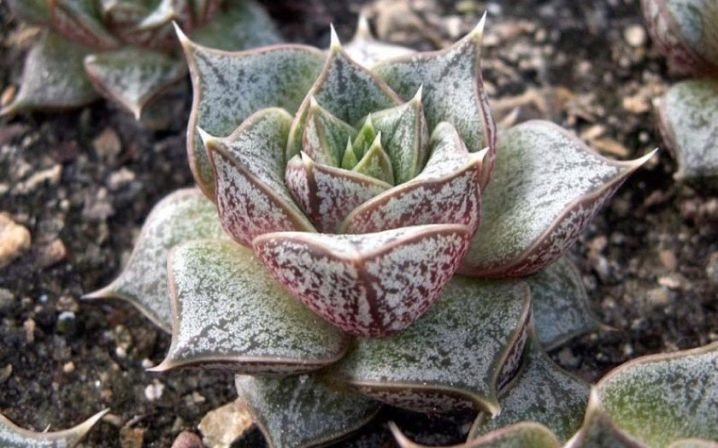
Miranda
Several rosettes grow on the bush at once, similar in appearance to lotus inflorescences. This species is solely the merit of the breeders. As a result of their labor, there are many subspecies of Miranda echeveria with a wide variety of leaf colors: different shades of yellow, pink, silver or lilac. The shrub has quite impressive volumes. Significant leaf plates have a rounded shape with a pointed apex.
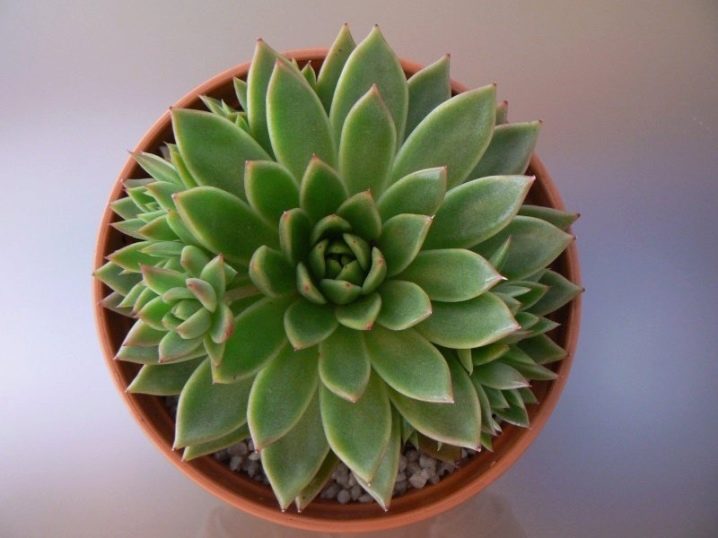
Black Prince
Belongs to hybrid varieties. The color of its foliage is actually black, hence the name. The bush does not differ in special dimensions, respectively, its plates are also small, slightly flattened on both sides. The central part of the rosette is much lighter and green. Black stone rose blooms from October to January, scarlet buds bloom on low arrows.
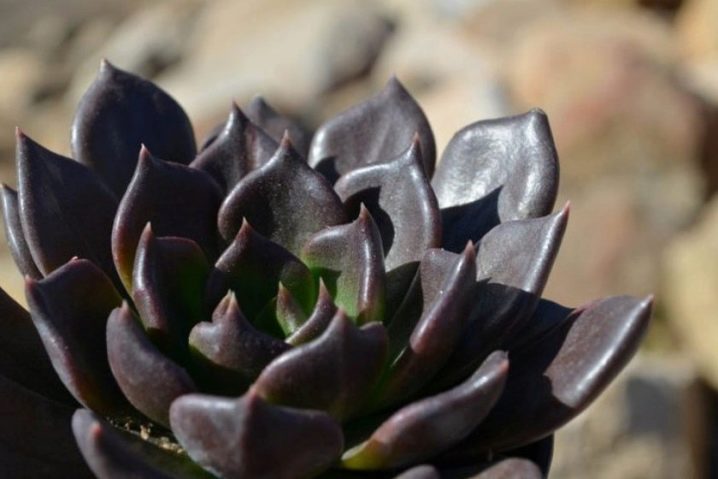
Lilacin
This variety grows very slowly. Leaves are dense, with a rough texture. The rosette is massive, its color can vary from gray-blue to lilac. The bush produces flexible arrows with soft coral or pink flowers. Succulent blooms from February to May.
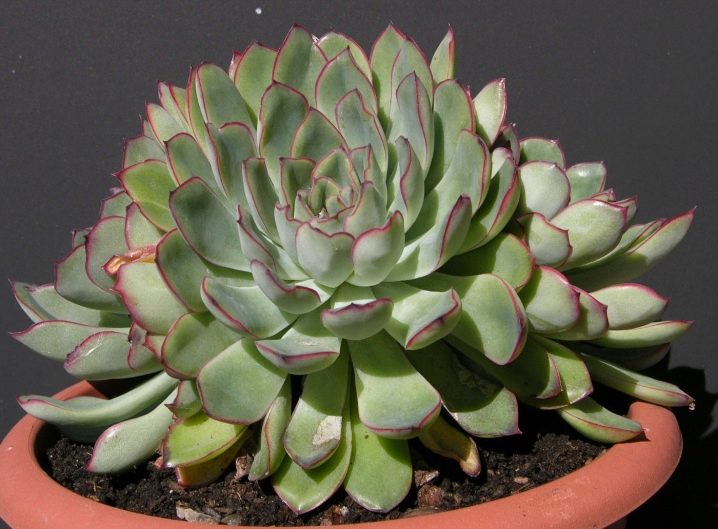
In a brightly lit location, the leaf plates acquire a wax coating, giving the flower a whitish color.
Pulidonis
This variety differs in a peculiar color and structure. The characteristics of the variety include:
- socket diameter 15 cm;
- the plates are narrow and elongated;
- the main color is blue, and the border is bright pink;
- lack of a stem;
- blooms in summer;
- yellow buds in the form of a bell.
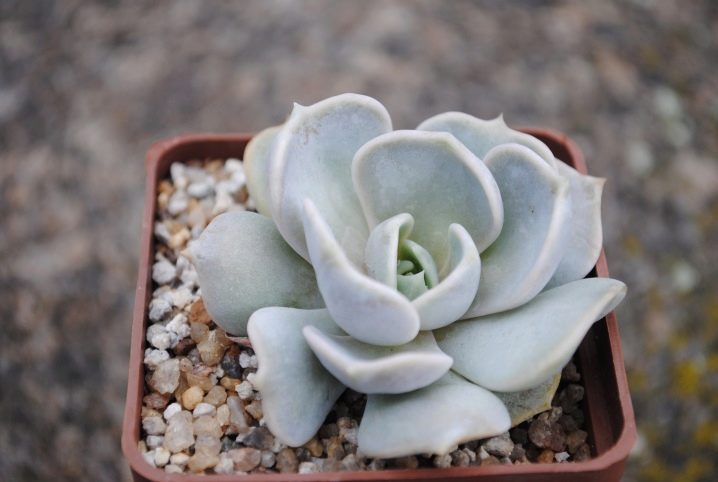
Sizaya
The peculiarity of this variety is the extraordinary color of the leaves. They are of a beautiful blue shade with a bluish sheen, rather large, but insignificant in width. Dense rosettes do not have a stem and are placed directly on the soil. In winter, the leaves acquire a pink border, and in spring, Echeveria begins to bloom with yellow buds.
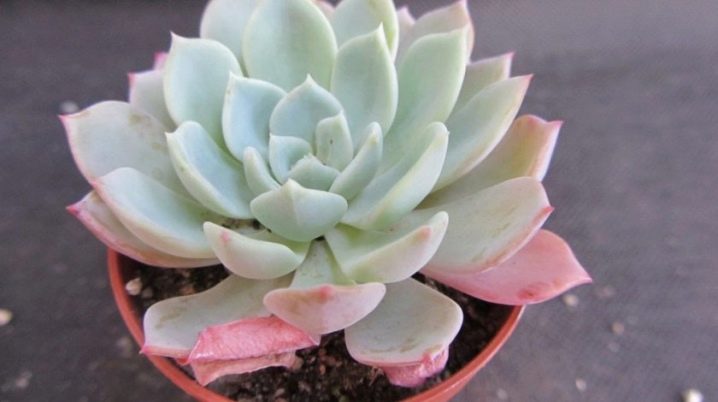
Desmet
This variety belongs to the classic variety. Leaves are silver-blue with a pink stripe framing the edges. The flowers have a bright orange color.
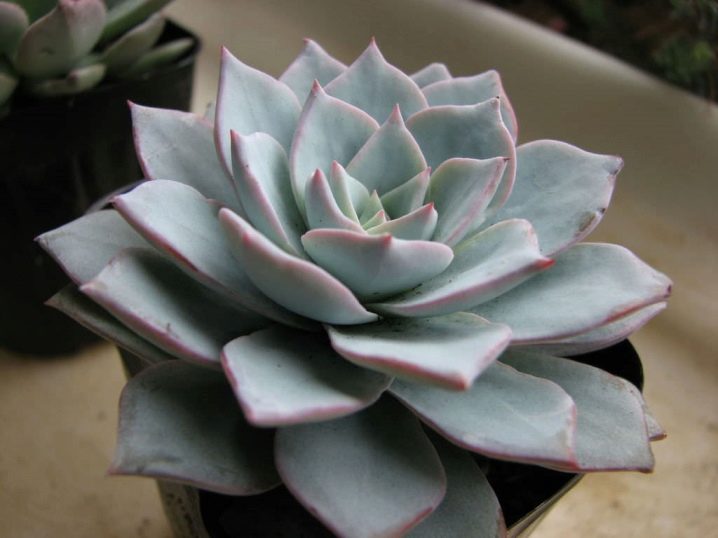
Nodulose
The bush does not differ in special growth. The leaves have an original pattern: their upper part is covered with red stripes, and the lower part is replete with large spots of the same tone. In March, flowering begins, flowers of a beautiful scarlet hue.
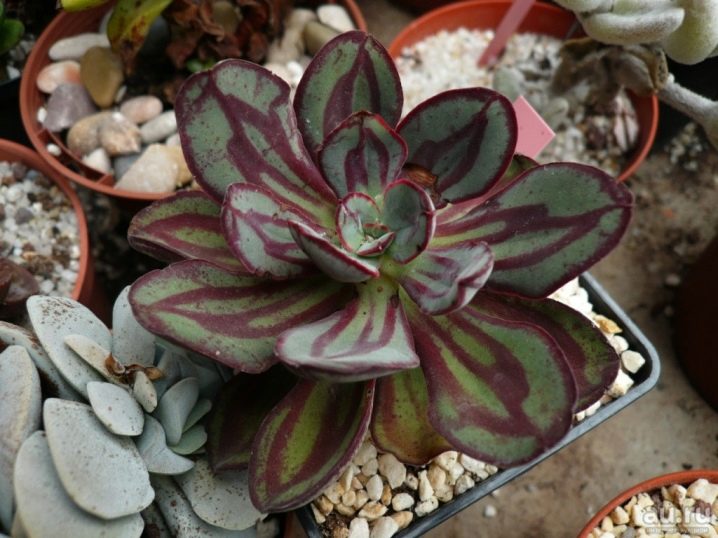
Amoena
It has thickened shoots, with tiny rosettes at the tips. The leaves are triangular, bluish in color. It blooms rarely, the petals are yellow with a reddish tint. "Amoena" is considered a very rare variety, propagated by a leaf.
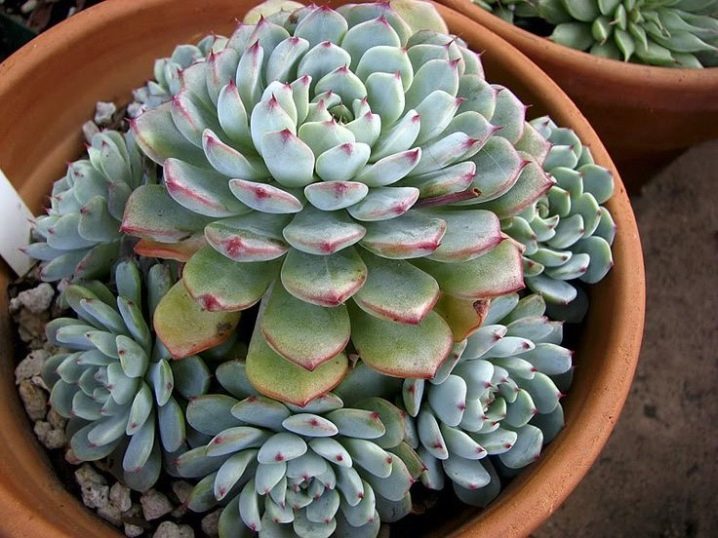
Cushion
Small bush with oblong, oval plates. The outside of the leaves is fleecy, pale green in color. It blooms in spring with small red-yellow flowers.
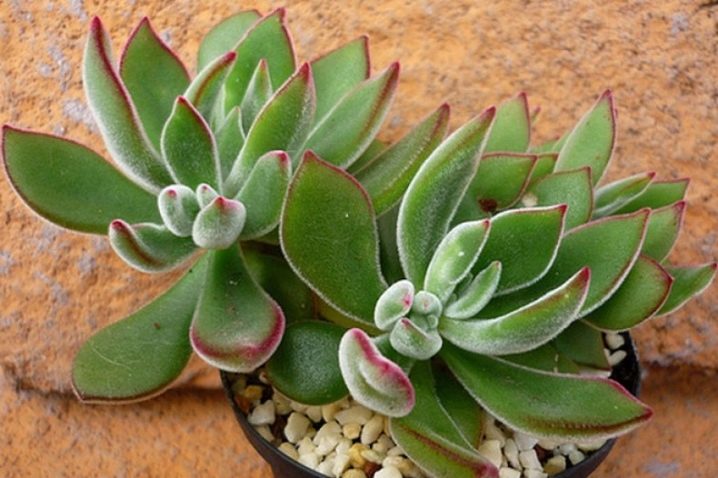
Shaw
It has a squat stem with large greenish rosettes, covered with soft gray hairs. The upper part of the plates is wavy, notched and has a pointed end. In mid-June, yellowish-pink buds begin to bloom. In winter, the bush loses almost all the greenery.
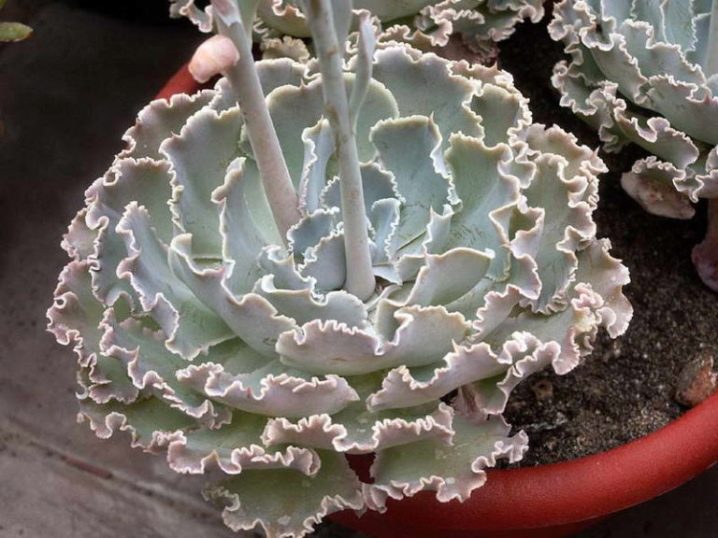
Lola
Green leaves with a light pink tone create a compact rosette. Bells, yellow or coral, bloom in the spring.
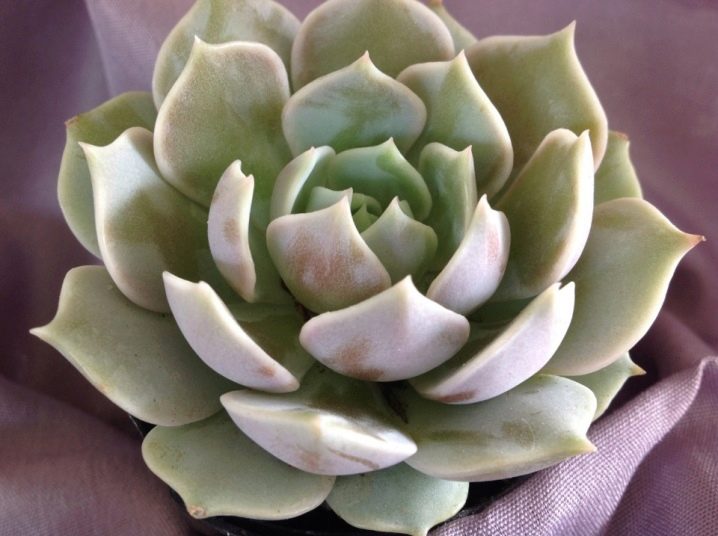
"Rainbow" or rainbow
It is a hybrid of the Pearl of Nuremberg. A feature of this species is the change in color of the rosette according to the change of season.Its central part is highlighted in bright pink. Echeveria is striking in the number of varieties and their varieties. In addition to those described above, there are many more of its hybrids. Such species as Topsi Torvi, Aurora, Elegance, Runyona, Best Western Cristata are also worthy of attention of flower growers.
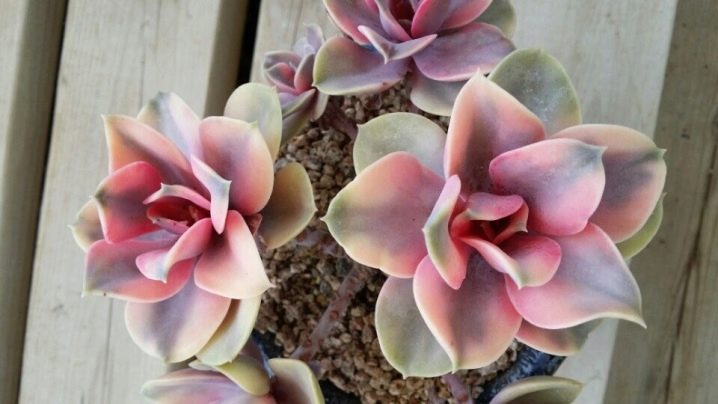
How to choose?
Echeveria is a picky and undemanding flower. To grow comfortably, he needs minimal care. When choosing a stone rose for yourself, you need to pay attention to the integrity of the leaves and the density of the rosette, they should not be damaged. Which variety to choose depends only on personal interests and preferences. Each type of flower has its own peculiarity and charm. They look great both as an independent plant and as components of various compositions. And it doesn't matter what kind of plant you buy, because any of them will not leave anyone indifferent.
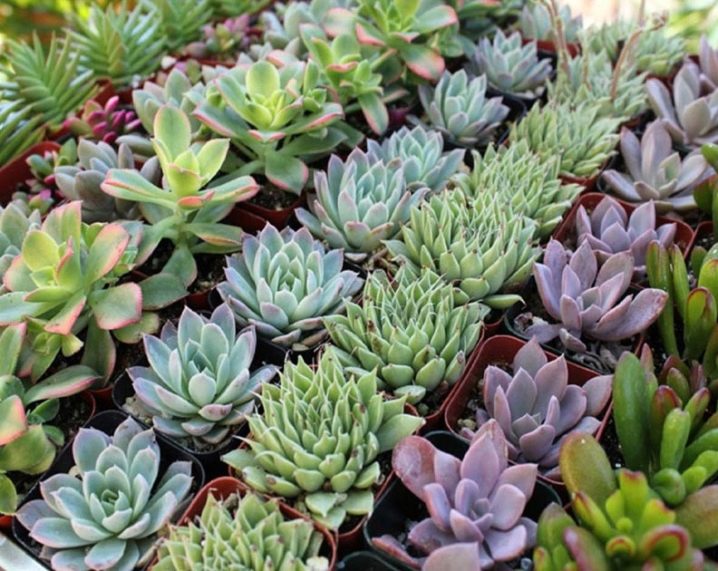
For information on how to properly care for echeveria, see the next video.
















































Thank you, everything is very intelligible and truthful. I got carried away by succulents.
The comment was sent successfully.